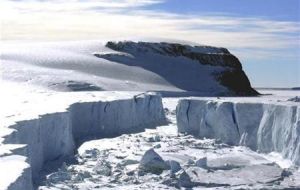MercoPress. South Atlantic News Agency
Polar ice sheets melting have added 11mm to global sea levels since 1992
 Professor Shepherd of Leeds University says East Antarctica has acquired more mass because of increased snowfall
Professor Shepherd of Leeds University says East Antarctica has acquired more mass because of increased snowfall Nearly two dozen research teams collaborated to study polar ice sheets in Greenland and Antarctica and discovered definitively that they have added 11mm to global sea levels since 1992, melting ever more quickly.
This polar melting added about one-fifth of the overall global sea level rise in this period, contributing 11.1mm overall but with a “give or take” uncertainty of 3.8mm, such that the figure could be anywhere between 7.3mm and 14.9mm. All the ice sheets’ combined rate of melting has grown since 1992, with Greenland losing five times as much ice now and Antarctica showing about a 50 per cent increase ice loss rate for the last decade.
The results, which bring to an end 20 years of conflicting results, were published in Science. Researchers used data from satellites measuring the surface altitude, glacier flow and the ice mass’s gravitational effect. Erik Ivins of California's Jet Propulsion Laboratory said the 11.1mm are significant.
“When you have 11mm of increased sea level, if you compute the amount of mass that's capable of coming on shore during storm surge, it's a lot of mass,” he said, according to The Canadian Press. “Small changes in sea levels in certain places mean very big changes in the kind of protection of infrastructure you need to have in place.”
Lead author of the research, Professor Andrew Shepherd of Leeds University, explained that East Antarctica ice sheet, which is the largest, has acquired more mass due to increased snowfall. Still, the study determined that Greenland, West Antarctica and the Antarctic Peninsula were all losing mass, more than offsetting East Antarctica's gain.
“We can now say for sure that Antarctica is losing ice and we can see how the rate of loss from Greenland is going up over the same period as well,” he said. “We've brought everybody together to produce a single estimate and it turns out that estimate is two to three times more reliable than the last one.”
He noted that the figure is in line with climate change predictions.
“We would expect Greenland to melt more rapidly because the temperatures have risen,” he commented. “We would expect West Antarctica to flow more quickly because the ocean is warmer. And we would also expect East Antarctica to grow because there's more snowfall as a consequence of climate warming.”
The findings are in line with various forecasts by the UN's Intergovernmental Panel on Climate Change 2007 assessment, and will be considered for the next report due in September 2013.
“The next big challenge - now that we've got quite a good understanding of what's happened over the last 20 years - is to predict what will happen over the next century,” said Dr Hamish Pritchard of the British Antarctic Survey. ”And that is going to be a tough challenge with difficult processes going on in inside the glaciers and ice sheets.”




Top Comments
Disclaimer & comment rules-

-

-

Read all commentsThat ice is drifting towards rgenweener so it must be theirs
Dec 05th, 2012 - 10:00 pm 0Phew!!!!
Dec 06th, 2012 - 12:51 am 0After seeing Mr Brown and his friends safely off to the coast,
i too fear, I may have just added a few more millimeters to the sea level.
maybe argentina could haul it in and stake a claim on that!
Lead author of the research, Professor Andrew Shepherd of Leeds University....noted that the figure is in line with climate change predictions. Of course it would have to be , although computer models cannot predict, they can only project scenarios and they are reliant on the information fed to them.
Dec 06th, 2012 - 12:15 pm 0http://www.nipccreport.org/articles/2012/feb/14feb2012a1.html
Geophysical Research Letters 38: 10.1029/2011GL049444.
“4000 years history of Greenland surface temperature”
They note that ”the current decadal average surface temperature at the summit is as warm as in the 1930s-1940s, and there was another similarly warm period in the 1140s (Medieval Warm Period),“ indicating that ”the present decade is not outside the envelope of variability of the last 1000 years.“ In fact they say that ”excluding the last millennium,“ there were fully ”72 decades warmer than the present one, in which mean temperatures were 1.0 to 1.5°C warmer,“ and that during two centennial intervals, average temperatures ”were nearly 1.0°C warmer than the present decade.“
Also, At WUWT: ”New proposal from NASA JPL admits to “spurious” errors in current satellite based sea level and ice altimetry, calls for new space platform to fix the problem.“
Anthony Watts comments:
”This recent internal PowerPoint presentation (obtained from an insider) from NASA JPL touts the new GRASP (Geodetic Reference Antenna in Space) satellite project. I’d say it is more than a bit of a bombshell because the whole purpose of this new mission is to “fix” other mission data that apparently never had a stable enough reference for the measurements being made. This promises to rewrite what we know about sea level rise and acceleration, ice extent and ice volume loss measured from space.”
Back to the drawing board.....
Commenting for this story is now closed.
If you have a Facebook account, become a fan and comment on our Facebook Page!